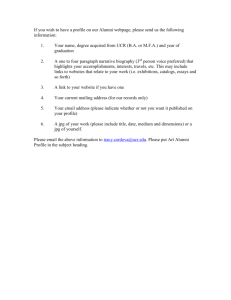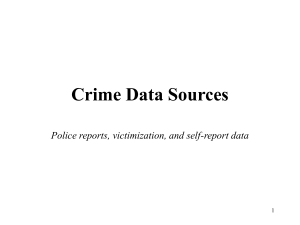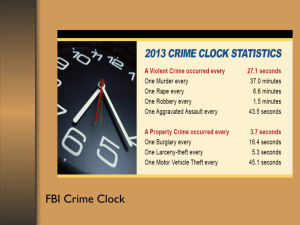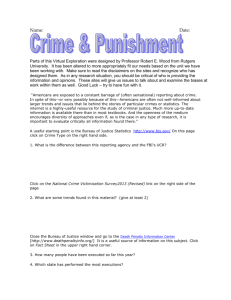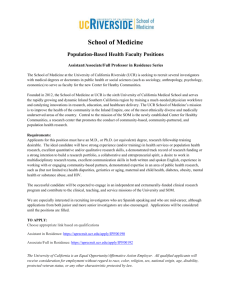Chapter 10 – Survey/Interview Research Methods (pp. 233
advertisement
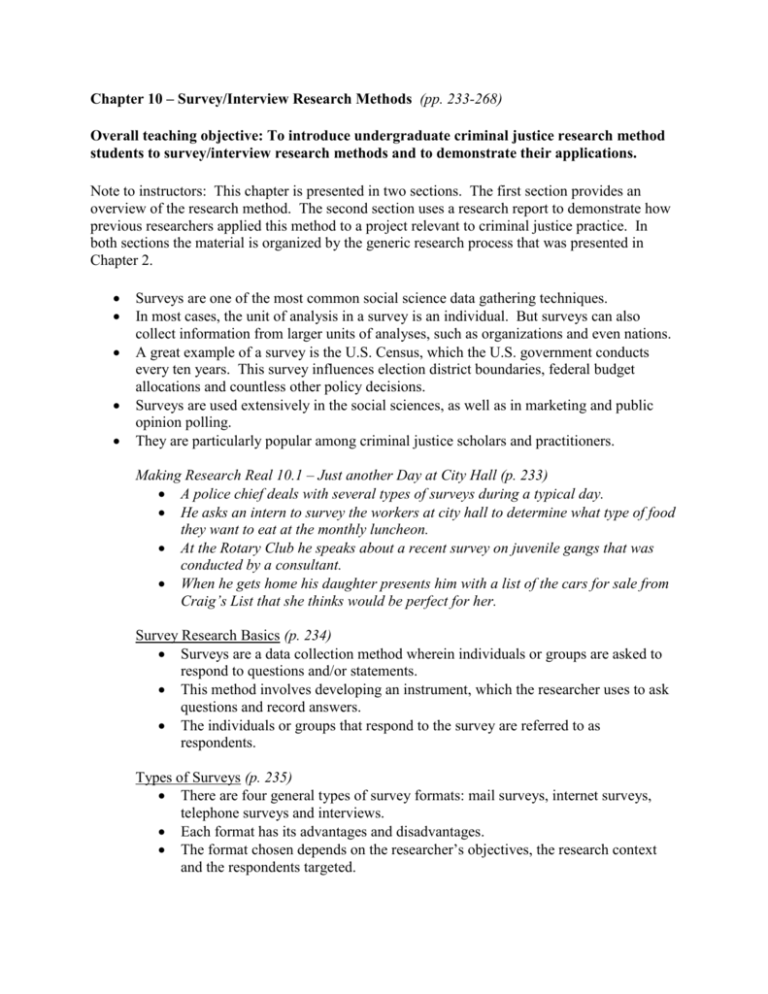
Chapter 10 – Survey/Interview Research Methods (pp. 233-268) Overall teaching objective: To introduce undergraduate criminal justice research method students to survey/interview research methods and to demonstrate their applications. Note to instructors: This chapter is presented in two sections. The first section provides an overview of the research method. The second section uses a research report to demonstrate how previous researchers applied this method to a project relevant to criminal justice practice. In both sections the material is organized by the generic research process that was presented in Chapter 2. Surveys are one of the most common social science data gathering techniques. In most cases, the unit of analysis in a survey is an individual. But surveys can also collect information from larger units of analyses, such as organizations and even nations. A great example of a survey is the U.S. Census, which the U.S. government conducts every ten years. This survey influences election district boundaries, federal budget allocations and countless other policy decisions. Surveys are used extensively in the social sciences, as well as in marketing and public opinion polling. They are particularly popular among criminal justice scholars and practitioners. Making Research Real 10.1 – Just another Day at City Hall (p. 233) A police chief deals with several types of surveys during a typical day. He asks an intern to survey the workers at city hall to determine what type of food they want to eat at the monthly luncheon. At the Rotary Club he speaks about a recent survey on juvenile gangs that was conducted by a consultant. When he gets home his daughter presents him with a list of the cars for sale from Craig’s List that she thinks would be perfect for her. Survey Research Basics (p. 234) Surveys are a data collection method wherein individuals or groups are asked to respond to questions and/or statements. This method involves developing an instrument, which the researcher uses to ask questions and record answers. The individuals or groups that respond to the survey are referred to as respondents. Types of Surveys (p. 235) There are four general types of survey formats: mail surveys, internet surveys, telephone surveys and interviews. Each format has its advantages and disadvantages. The format chosen depends on the researcher’s objectives, the research context and the respondents targeted. Table 10.1 - Advantages and disadvantages of different survey formats. (p. 236) Survey format Advantages Disadvantages Mail survey o o o o Internet survey o Lowest cost o Worldwide coverage o Reduces data entry error o Possible sampling bias o Lack of distribution lists Telephone survey o o o o Wide coverage Higher response rates Better communication Reduces data entry error o o o o o o Interview o o o o o Highest response rate Allows for longer surveys Control of the conditions Better communication Reduces data entry error o Most expensive o Possibility for interviewer bias o Variation among interviewers Low cost Wide coverage Anonymity Avoids interviewer bias o o o o o Low response rates No control of the conditions Length limitations Possibility of miscommunication Data entry error More expensive Length limitations No visual communication tools Not possible to interrupt survey Sampling bias Decreased use of landline phones The Benefits and Limitations of Survey Research (p. 238) Table 10.2 - The uses of the survey research method. (p. 240) Developing a community or group profile (i.e., what people look like) Learning how people behave (i.e., what people do) Measuring attitudes, beliefs and opinions (i.e., what people think). Determining levels of knowledge (i.e., what people know) Predicting future trends and patterns (i.e., what people will do) Table 10.3 - The limitations of the survey research method. (p. 242) Difficulty in determining causal relationships between variables Inability to measure or illuminate complicated or unknown social phenomena Possible inaccuracies and dishonesty in respondents’ self-reported behavior, attitudes and knowledge Validity, or whether a survey question measures what it purports to measure, is often a threat Making Research Real 10.2 – Neighborhood Crime Survey (p. 239) During a meeting of a neighborhood association a Community Services Officer learns about an increase in burglaries. The officer conducts a survey about the resident’s habits (e.g. locking doors, informing neighbors when they are out of town, etc.) The results of this survey will be used to develop a plan to reduce burglaries in the neighborhood. Making Research Real 10.3 – The Effect of Marriage on Criminal Behavior (p. 240) A correctional administrator conducts a survey of inmates and learns that 80 percent of them are not married. The administrator concludes that marriage has a deterrent effect on criminal behavior. However, the administrator failed to consider whether the inmates were married or the status of their marriage at the time of their offense. This illustrates the inability of a survey to establish a causal linkage between variables. Note to instructors: In this section the research method is discussed within the context of a relevant research project. The material is organized by the generic research process that was presented in Chapter 2. The story (i.e. the research project that provides the context) is presented in a series of set out boxes called Developing the Method. These are repeated here to allow instructors to use the research to teach the concepts, tools and techniques related to this research method. The Survey Research Process (p. 242) Learning a new research method is easier when you can see how another person applied the method in an actual research situation. In this section, we will take a look at how a researcher might administer a survey following the basic steps of the research process outlined in Chapter 2. At the end of each research step, you will find the now familiar boxes entitled “Developing the Method”. Again, these boxes describe an actual survey that was conducted in the field of criminology. We begin with a general introduction of this case study of survey research. Developing the Method 10.1 – A Case Study in Survey Research (p. 242) Since 1930, the Federal Bureau of Investigation (FBI) has collected information on crimes reported to local police departments under a program called the Uniform Crime Reports (UCR). These data are collected at the local level, summarized at the state level and sent to the FBI on a quarterly basis. Each year, the FBI uses these data to produce reports on crime and other police administration issues. The most notable of these reports is called Crime in the United States. This annual report is widely distributed and used as the national measure of crime. For all practical purposes, each individual UCR is a survey. The FBI asks each police department to respond to questions regarding crimes reported in their precincts and other administrative issues. Despite its utility, the UCR is limited in that it only provides statistics on crimes actually reported to the police. There are a large number of crimes that are never reported. To supplement the UCR, the Bureau of Justice Statistics (BJS), part of the U.S. Department of Justice, periodically conducts a survey on criminal victimization. This survey, conducted by telephone, involves a very large sample of residents in the United States. The survey, known as the National Crime Victimization Survey (NCVS), asks respondents about their experiences with criminal victimization regardless of whether they reported it to the police. The NCVS includes crimes not reported to the police, but there is no way to verify the accuracy of the information reported by survey respondents. Despite their respective limitations, the UCR and NCVS together provide a fairly good snapshot of crime throughout the United States at particular times. Ask a Research Question (p. 243) Generally speaking, surveys are effective for describing a particular group or subpopulation, a particular set of behaviors and beliefs, and/or a particular relationship between variables. Developing the Method 10.2 – Asking a Research Question in Survey Research (p. 244) The UCR traces its origins to the 1920’s, when the International Association of Chiefs of Police identified a need to measure crime at the national level. In response, the United States Congress authorized the FBI to create a national clearinghouse for statistical information on crime in 1930. This became known as the UCR program. Participation in the UCR program is voluntary, but nearly every university, city, county, state, tribal and federal policing agency participates (Federal Bureau of Investigation, 2009). The UCR collects data on a limited number of crimes that are officially reported to the police and crimes that are cleared by an arrest. These crimes are organized into two parts. Part I crimes are the most serious and include murder and non-negligent manslaughter, forcible rape, robbery, aggravated assault, burglary, larceny-theft, motor vehicle theft, and arson. Part II crimes are less serious and include driving while intoxicated, simple assault, and drug-related crimes. The NCVS was started more recently. It began in 1973 and is conducted by the U.S. Census Bureau on behalf of the Bureau of Justice Statistics. The NCVS collects information on personal and household victimization using a nationally representative sample of households. This information is collected directly from the victims themselves. There are no limits on the types of crimes it allows victims to report, with one obvious exception: the NCVS does not collect information from murder victims. Both the UCR and NCVS surveys are descriptive in nature. Neither attempt to explain the reason for crime. Their primary purpose is to collect information so that practitioners, policy makers, and professors have access to data to study crime rates and trends. As such, these data lend themselves to applied and pure research. Conduct a Literature Review (p. 244) In addition to the usual information researchers look for when conducting a literature review, survey researchers should pay particular attention to how previous researchers defined similar concepts, measured key variables and designed survey instruments. Developing the Method 10.3 - Conducting a Literature Review in Survey Research (p. 245) Because the UCR and NCVS are on-going, researchers involved in their administration do not typically conduct extensive literature reviews. The crime categories in the UCR have remained relatively constant for decades. And this is imperative since it allows researchers to compare crime rates from one year to the next. It is equally important for the UCR staff to reconcile definitional differences between jurisdictions so that similar criminal behaviors are defined consistently throughout the survey. Jurisdictions may change penal code definitions and may even decriminalize some behaviors. The UCR staff must be vigilant about staying on top of these changes to ensure the continuity of their survey’s results. One of the most recent threats to the administration of the NCVS, which relies on contacting respondents via the telephone, is the decrease in the number of landline telephones. An increasing number of telephone users are abandoning landline services and opting to use cellular telephone services exclusively. Cellular telephone numbers are not as accessible as landline telephone numbers. Furthermore, cellular telephone users appear more resistant to responding to telephone surveys. The effect of this social phenomenon on the validity of the NCVS is not yet known. But it is essential that the researchers responsible for conducting the NCVS evaluate the available literature on how this might affect telephone survey research. Refine the Research Question (p. 246) Because most surveys are intended for descriptive and exploratory research, hypotheses that predict causal relationships between variables are not usually found in survey research. Instead, survey researchers develop hypotheses that predict relationships between variables and/or refine research questions about particular phenomena. Developing the Method 10.4 - Refining the Research Question in Survey Research (p. 246) Since their purpose is to produce descriptive data, the UCR and NCVS do not use formal research hypotheses. Further, the research questions that drive both surveys have changed only slightly over time. For the most part, each survey asks the same questions about the same crimes, since the purpose is to produce longitudinal data. But new questions are introduced as new crimes and crime trends emerge. For example, the UCR only began collecting data on hate crimes quite recently. And it would not be surprising to find new questions on the NCVS as new forms of criminal victimization emerge. For example, a decade ago identity theft was relatively rare. Now it is one of the fastest growing forms of criminal behavior in America. Define the Concepts and Create the Measures (p. 246) Defining and measuring concepts is especially important in survey research. Concepts and measures should be consistent throughout the survey research process. More importantly, survey researchers must be sure that the respondents interpret the concepts and measures as they were intended to be understood. This is normally done during a preliminary test of the survey instrument. Developing the Method 10.5 - Defining Concepts and Creating Measures in Survey Research (p. 247) With respect to conceptualization, there are differences in how the UCR and NCVS define the term ‘crime’. According to the UCR, a behavior is not a crime until it has been reported as a crime to the police. If a crime is never reported to the police or if the local agency does not participate in the UCR program, the crime is never counted. Some crimes, like murder, robbery and burglary, have a higher probability of being reported to the police. Other crimes, like rape, embezzlement or simple assault have a lower probability of being reported to the police. Note that the UCR does not collect data from prosecutors or courts. Therefore, there is no way to know whether or not criminal suspects were convicted or sentenced for the crimes that were reported. In 1988, the FBI responded to this flaw by creating the National Incident-Based Reporting System (NIBRS), which collects information on reported crimes, as well as any subsequent arrests, prosecutions and sentencing for each crime incident. The UCR requires reporting agencies to determine how their state or local criminal offenses fit into the approved UCR crime categories. But there are some discrepancies between how reporting agencies define certain crimes and how the UCR defines certain crimes. For example, the UCR collects information on forcible rape. The UCR defines forcible rape as “the carnal knowledge of a female forcibly and against her will”. Using this definition, the rape of a male would not count as ‘forcible rape’ for UCR data collection purposes. Decades ago, many states began amending their rape statutes to recognize that a man could be raped. As a result, a discrepancy between state rape statutes and the UCR’s forcible rape definition emerged. Currently, the UCR instructs agencies to report male rape as an assault or other sexual offense rather than a forcible rape. Note that the definition of forcible rape in the newer NIBRS system is broader. Under this program, a forcible rape is defined as “the carnal knowledge of a person, forcibly and/or against that person’s will; or not forcibly or against the person’s will where the victim is incapable of giving consent because of his/her temporary or permanent mental or physical incapacity or because of his/her youth” (Federal Bureau of Investigation, 2009). This definition includes adult males and children rape victims. In contrast to the UCR, the NCVS defines crime from the victim’s perspective. The NCVS is more interested in the consequences and effects of personal and household victimization and is less concerned about the legal issues of an alleged criminal incident. The NCVS does not collect data from police agencies, prosecutors or courts. So there is no way to know whether the crime actually happened or whether the alleged offenders were actually arrested, convicted or sentenced. Instead, this survey collects information about the relationship between the victim and the offender, the characteristics of the offender (if known), self-protection actions taken by the victim during the incident, whether the offender used a weapon and other descriptive information about the victim. The NCVS categorizes crimes that are reported by victims, though in a less formal way than the UCR. The NCVS differentiates between personal crimes (rape and sexual attack, robbery, aggravated and simple assault and purse-snatching/pocket-picking) and property crimes (burglary, theft, motor vehicle theft, and vandalism). But it does not require respondents to use stringent legal definitions when identifying crimes that have been committed against them. For example, if a woman reports that her purse was stolen, it might be classified as a purse snatching, a robbery (if the offender used a weapon or stole the purse by force), or a burglary (if the purse was taken from the woman’s home). How the crime is classified really depends on how much information the victim provides to the survey taker and how the victim defines the incident. Design a Method (p. 248) In general, survey questions should be written clearly and at a level that is appropriate for the respondent’s level of education and experience. In addition, survey researchers should adhere to the rules of mutual exclusivity and exhaustiveness when writing response sets. Table 10.4 – Considering the respondents’ literacy while writing survey questions. (p. 248) Type of respondent Effective questions Adults About what percent of your income is spent on discretionary purchases? Teenagers Considering the money you earn, about what percent of it is spent on things like movies, video games, and things you want but don’t really need? Children Do your parents give you money, such as an allowance? If so, how much of that money do you spend on things like candy, soda and toys? Survey questions and statements should not contain jargon, slang, uncommon abbreviations, emotional language and prestige bias. In addition, survey researchers should avoid asking double-barreled and leading questions. Finally, survey questions should be ‘answerable’. Table 10.5 – Considerations for writing survey questions. (p. 251) Consideration Objective Avoid confusion Questions should be written as simply as possible so that the vast majority of the respondents will likely understand them. The literacy of the respondents Questions should be written to the lowest reading comprehension level that exists within the sample of respondents. Mutual exclusivity Response sets (if used) should be written so that each respondent has one and only one answer to a question or statement. Exhaustive Response sets (if used) should be written so that each respondent has an option. This may require the use of an ‘other’ category. Avoid jargon, slang and uncommon abbreviations It should not be assumed that survey respondents will be familiar with terms that may be commonly used by individuals (including researchers) within a particular industry or social group. Avoid opinionated or emotional language Questions should not prejudice a respondent’s answer. Avoid double barreled questions Questions should ask one and only one thing. Avoid prestige bias Questions should not include phrases that suggest the answer is ‘already known’ by more informed people. Avoid questions that the respondent is likely unable to answer Questions should not assume that the respondents have prior or detailed knowledge about a particular issue. Avoid leading questions Questions should not include, within them, the answer or an ‘obvious’ answer. There are three basic types of response sets. o Direct response sets allow the respondent to enter specific information into a blank space or box. o Open response sets also allow the respondent to write their own responses to questions, but are more open to interpretation than direct response sets. o Closed or forced choice response sets specify a standard set of responses from which the respondent must choose. Question order, survey instructions, and survey length are critical considerations in survey design. In general, the most challenging and important questions should be placed at the beginning of a survey and the least challenging questions should be placed near the end. Surveys should include an introduction to the survey, specific instructions for answering each question, and concluding instructions on how to return the survey. In terms of length, shorter surveys are better than longer surveys since longer surveys tend to reduce the respondent’s willingness to complete the survey. A preliminary test of the survey instrument in an environment and with a small representative group of respondents is essential for ensuring the success of a survey instrument. The purpose of this step is to determine whether the respondents will understand the survey and whether the survey instrument will produce the kind of data necessary to answer the research question(s). Developing the Method 10.6 - Designing a Method in Survey Research (p. 255) When the UCR program was being developed, decisions around methodology were heavily influenced by a specially appointed committee of experts and practitioners from the International Association of Chiefs of Police and later the National Sheriff’s Association. Before it was officially launched, the program pretested its survey methods through demonstration projects involving a few reporting agencies. With respect to design, the early years of the program had participating agencies using paper forms to tabulate and report the number of crimes reported and arrests made. These paper forms are no longer used. Instead, state level clearinghouses collect data from the reporting agencies electronically and transmit it in summary form to the national clearinghouse each quarter and again at the end of each calendar year. The NIBRS began as a pilot project in 1988 involving only one agency, namely the South Carolina Law Enforcement Division. Once the ‘bugs’ were worked out of the reporting system, the program was expanded. As of 2007, 6,444 agencies contribute data to the NIBRS program. Collectively, these agencies represent about 25 percent of the United States population. The original design of the NCVS program, which began in 1972, was developed by the National Opinion Research Center and the President’s Commission on Law Enforcement and the Administration of Justice. Like the UCR and NIBRS systems, this program was pilot tested before it was fully implemented. The NCVS has always relied upon a telephone survey to collect its data. Crime victims are more likely to be accessible and more likely to share their information via the telephone than on a paper survey. Though face-to-face interviews with crime victims would be ideal, they are too expensive to make them feasible in this case. Over the years, the United States Congress has asked the UCR and NCVS to expand its data collection to include new crimes, identify emerging crime patterns, and collect data on politically sensitive crimes. In the early 1990’s, for example, the UCR began collecting data on crime occurring on university and college campuses. Later, the UCR was asked to collect information on hate crimes. Likewise, the NCVS has expanded its reach to include school violence and attitudes about crime or the police. In every case, program administrators pilot-tested the changes they made to their reporting systems well before they were implemented. Collect the Data (p. 256) The response to a survey can be improved by appropriately timing when the survey is administered, asking well designed questions, sending reminder post cards, and providing incentives to encourage the respondents to answer. Developing the Method 10.7 - Collecting Data in Survey Research (p. 257) Because both the UCR and NCVS are ongoing, surveys implementation is constant. Nearly every state has a staff of UCR field representatives who are assigned to assist agencies with reporting the requested data. These field representatives are often part of each state’s criminal history records repositories and are paid by the state government. They conduct regular training for the reporting agencies to ensure they comply with the current reporting rules. And each quarter, they compile the information from the reporting agencies and transmit these data to the UCR headquarters. Though participation in the UCR has always been voluntary, all but a few agencies participate since most law enforcement agencies understand the importance of collecting data on crime. Many states have gone so far as to enact statutes or administrative rules to compel agencies to participate. Thus, ensuring a good response rate is less of an issue in the case of the UCR. In the case of the NVCS, there are no reporting agencies to communicate with since this survey is administered to a random sample of U.S. households. Each year, the NCVS collects victimization data from a representative sample of about 76,000 households, representing approximately 135,000 persons throughout the nation. The NCVS must draw a comparatively large sample because crime is a relatively rare event. As we learned in a previous chapter, when events occur rarely within a population, sample sizes must be large enough to ensure enough cases. In recent years, the NCVS has recognized that an increasing number of people do not have a landline telephone, especially younger people who tend to have higher criminal victimization rates. This has caused some concern over sampling bias since collecting victimization data from cell phone users is becoming increasingly difficult. Analyze the Data (p. 257) The use of subscripts on written survey instruments enhances accuracy during the data entry phase. This is known as coding the data. Once data are entered, researchers can use various statistical techniques to analyze survey data. Developing the Method 10.8 - Analyzing Data in Survey Research (p. 259) The most well known statistic available from the UCR is the crime rate, sometimes called the index crime rate. A crime rate is calculated for each type of crime and for different categories of crime. Crime rates are calculated by using the following formula: Number of reported crimes for each category / The population of the community x 100,000 The index crime rate for a community, county, region, state or the nation is always expressed in the UCR program as the number of crimes per 100,000 residents. This provides a standard measure of criminal activity. So if there were 400 aggravated assaults in a community with a population of 200,000, the crime rate for aggravated assault in that community would be 200 per 100,000 residents that year. The NCVS calculates a similar crime rate from the data it collects from a sample of U.S. households. As the formula above suggests, a change in the crime rate can occur as a result of either a change in the number of reported crimes or a change in the community’s population. If both the number of crimes and the population increase, the crime rate might actually remain constant. And if a community’s population increased dramatically while the number of crimes remains constant, it might appear that crime is decreasing when it is not. The opposite might also happen; a decreasing population with a stable number of crimes might register elevated crime rates. In situations like these, survey researchers would enter explanatory footnotes next to their results to document the reasons for a change in the crime rate. Remember that in the UCR program, there is no relationship between the number of crimes reported and the number of arrests. An agency may receive a report of an aggravated assault one year but not make an arrest for that particular assault until the next, if at all. Reporting agencies simply report the number of crimes reported and the number of arrests made that year. Even so, these two variables are used to create a statistic called the clearance rate. If an agency reports receiving 100 aggravated assault cases, but made only 50 arrests for aggravated assault that year, it would have a clearance rate of 50 percent for that year. An uninformed individual may conclude that the agency only solves half of its aggravated assaults. On occasion, an agency reports that it arrests more people for a particular crime than it received reports for that crime. In this case, the agency would have a clearance rate higher than 100 percent and it may appear that the department is solving crimes that have not even been reported! This is a statistical anomaly that cannot be corrected under the current UCR reporting rules. This is one of the reasons that the UCR program created the NIBRS program, which is incident-based. Interpret the Results (p. 260) The interpretation of survey results is often more art than science. The focus of the interpretation should be on answering the research question(s) as comprehensively as possible. To fully interpret survey results, researchers should consider the limitations of their data. Developing the Method 10.9 – Interpreting the Results of Survey Research (p. 260) Neither the UCR nor the NCVS is designed to measure crime quickly. There is often a substantial time lag between when the data are reported to the clearinghouses and when the data are published. And, often, the final results are not published until well into the following year. As such, the UCR and NCVS data are best suited for tracking crime over time. Remember, too, that the UCR program only collects information on crimes reported. Likewise, the NCVS program only collects information on criminal victimization. Alone, each data set has its limitations. As a result, many practitioners and scholars use UCR and NCVS in combination. Together, these two surveys produce a powerful measure of crime nationwide. In some years, the UCR reports an overall decrease in crime while the NCVS reports an overall increase in victimization, or vice versa. But other times, these two broad measures of crime report the same trend. Over time, these similar findings lend credibility to each other. With rare exceptions, both the UCR and NCVS have reported decreases in reported crime and criminal victimization since the early 1990’s. Taken together, these independent surveys allow criminologists to be more confident in concluding that crime has been on the decrease for well over two decades. There are other limitations to the UCR and NCVS data sets. The NCVS only measures crime at the national level, whereas the UCR calculates a crime rate for each community and state that participates in the program. The NCVS includes information on a broader range of criminal victimization, whereas the UCR limits its analysis to certain types of crime. The UCR collects additional administrative information from participating agencies, such as the number of sworn and non-sworn personnel employed by each participating agency. In sum, the UCR and NCVS each answer particular questions about crime, but not all questions about crime that we might be interested in asking. Communicate the Findings (p. 261) The most important part of a survey research report is the section wherein the researcher describes, in detail, the method by which he or she conducted the research. Survey research reports also typically include a table that describes the survey respondents and tables and graphs that report the results of any statistical tests. The decision about where to report the results of a survey depends on the intentions of the researcher and the audience they would like to reach. Developing the Method 10.10 – Communicating the Findings from Survey Research (p. 262) Both the UCR and NCVS programs publish annual reports. The UCR publication, Crime in the United States, is widely circulated. You often see news articles in local newspapers pick up on this information. Publication of the NCVS report is not as well publicized. Normally the results are released electronically. Both programs provide researchers access to their data and methodologies. Data from both programs are used sporadically throughout the year to demonstrate the current state of crime or trends over a period of years. Because of their influence on criminal justice policy, both the UCR and NCVS reports are subjected to extensive internal editing prior to their publication. Information provided to the UCR by participating agencies, for example, is evaluated numerous times at the local, state and federal levels. Although neither report is subjected to a traditional peer review process, they are extensively fact checked. Occasionally mistakes are made. And more than a few police chiefs have complained of errors in the UCR data when their mayors and city council members use it to question the effectiveness of the local police department. Getting to the Point (Chapter Summary) (p. 263) Surveys are a data collection method wherein individuals or groups are asked to respond to questions and/or statements. This method involves developing an instrument, which the researcher uses to ask questions and record answers. The individuals or groups that respond to the survey are referred to as respondents. There are four general types of survey formats: mail surveys, internet surveys, telephone surveys and interviews. Each format has its advantages and disadvantages. The format chosen depends on the researcher’s objectives, the research context and the respondents targeted. Survey research is effective for developing community or group profiles; learning how people behave; measuring attitudes, beliefs and opinions; determining levels of knowledge; and predicting future trends and patterns. Survey research is not effective for determining causal relationships between variables and measuring complicated or unknown social phenomena. Surveys should not be used when the honesty of the respondents is important to the research and their responses cannot be independently verified. It is often difficult to determine the validity of a concept or construct measured through a survey response. Generally speaking, surveys are effective for describing a particular group or subpopulation, a particular set of behaviors and beliefs, and/or a particular relationship between variables. In addition to the usual information researchers look for when conducting a literature review, survey researchers should pay particular attention to how previous researchers defined similar concepts, measured key variables and designed survey instruments. Because most surveys are intended for descriptive and exploratory research, hypotheses that predict causal relationships between variables are not usually found in survey research. Instead, survey researchers develop hypotheses that predict relationships between variables and/or refine research questions about particular phenomena. Defining and measuring concepts is especially important in survey research. Concepts and measures should be consistent throughout the survey research process. More importantly, survey researchers must be sure that the respondents interpret the concepts and measures as they were intended to be understood. This is normally done during a preliminary test of the survey instrument. In general, survey questions should be written clearly and at a level that is appropriate for the respondent’s level of education and experience. In addition, survey researchers should adhere to the rules of mutual exclusivity and exhaustiveness when writing response sets. Survey questions and statements should not contain jargon, slang, uncommon abbreviations, emotional language and prestige bias. In addition, survey researchers should avoid asking double-barreled and leading questions. Finally, survey questions should be ‘answerable’. There are three basic types of response sets. Direct response sets allow the respondent to enter specific information into a blank space or box. Open response sets also allow the respondent to write their own responses to questions, but are more open to interpretation than direct response sets. Closed or forced choice response sets specify a standard set of responses from which the respondent must choose. Question order, survey instructions, and survey length are critical considerations in survey design. In general, the most challenging and important questions should be placed at the beginning of a survey and the least challenging questions should be placed near the end. Surveys should include an introduction to the survey, specific instructions for answering each question, and concluding instructions on how to return the survey. In terms of length, shorter surveys are better than longer surveys since longer surveys tend to reduce the respondent’s willingness to complete the survey. A preliminary test of the survey instrument in an environment and with a small representative group of respondents is essential for ensuring the success of a survey instrument. The purpose of this step is to determine whether the respondents will understand the survey and whether the survey instrument will produce the kind of data necessary to answer the research question(s). The response to a survey can be improved by appropriately timing when the survey is administered, asking well designed questions, sending reminder post cards, and providing incentives to encourage the respondents to answer. The use of subscripts on written survey instruments enhances accuracy during the data entry phase. This is known as coding the data. Once data are entered, researchers can use various statistical techniques to analyze survey data. The interpretation of survey results is often more art than science. The focus of the interpretation should be on answering the research question(s) as comprehensively as possible. To fully interpret survey results, researchers should consider the limitations of their data. The most important part of a survey research report is the section wherein the researcher describes, in detail, the method by which he or she conducted the research. Survey research reports also typically include a table that describes the survey respondents and tables and graphs that report the results of any statistical tests. The decision about where to report the results of a survey depends on the intentions of the researcher and the audience they would like to reach.

